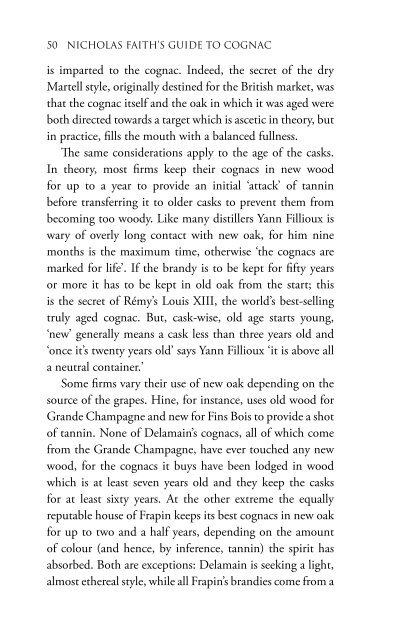Create successful ePaper yourself
Turn your PDF publications into a flip-book with our unique Google optimized e-Paper software.
is imparted to the cognac. Indeed, the secret of the dry<br />
Martell style, originally destined for the British market, was<br />
that the cognac itself and the oak in which it was aged were<br />
both directed towards a target which is ascetic in theory, but<br />
in practice, fills the mouth with a balanced fullness.<br />
The same considerations apply to the age of the casks.<br />
In theory, most firms keep their cognacs in new wood<br />
for up to a year to provide an initial ‘attack’ of tannin<br />
before transferring it to older casks to prevent them from<br />
becoming too woody. Like many distillers Yann Fillioux is<br />
wary of overly long contact with new oak, for him nine<br />
months is the maximum time, otherwise ‘the cognacs are<br />
marked for life’. If the brandy is to be kept for fifty years<br />
or more it has to be kept in old oak from the start; this<br />
is the secret of Rémy’s Louis XIII, the world’s best-selling<br />
truly aged cognac. But, cask-wise, old age starts young,<br />
‘new’ generally means a cask less than three years old and<br />
‘once it’s twenty years old’ says Yann Fillioux ‘it is above all<br />
a neutral container.’<br />
Some firms vary their use of new oak depending on the<br />
source of the grapes. Hine, for instance, uses old wood for<br />
Grande Champagne and new for Fins Bois to provide a shot<br />
of tannin. None of Delamain’s cognacs, all of which come<br />
from the Grande Champagne, have ever touched any new<br />
wood, for the cognacs it buys have been lodged in wood<br />
which is at least seven years old and they keep the casks<br />
for at least sixty years. At the other extreme the equally<br />
reputable house of Frapin keeps its best cognacs in new oak<br />
for up to two and a half years, depending on the amount<br />
of colour (and hence, by inference, tannin) the spirit has<br />
absorbed. Both are exceptions: Delamain is seeking a light,<br />
almost ethereal style, while all Frapin’s brandies come from a<br />
particularly favoured corner of the Grande Champagne, so<br />
they have enough basic strength to be capable of absorbing<br />
the tannins and other chemicals found in new wood.<br />
All the houses are aiming at a standard product from<br />
grapes that inevitably vary every year. If the year has been<br />
especially wet or the grapes are unusually ripe, the cognacs<br />
could be flabby, so Rémy Martin, for instance, stiffens their<br />
backbone with a longer stay in new wood. In very dry years<br />
the opposite applies. Some firms use old oak for Champagne<br />
cognacs and new wood for a third of those from the Bois.<br />
There is a regular routine as the brandies are gradually<br />
transferred to older and older casks. But the pace varies<br />
for, as Alain Braastad of Delamain says, ‘Every cask has its<br />
own personality because of the very different qualities of the<br />
wood in which it is lodged.’ All the blenders agree with him<br />
that while the brandy is above 40 per cent, the wood still<br />
contributes something to the final result.<br />
So, of course, do the chais in which the brandies are<br />
housed. These are a cross between a commercial warehouse<br />
and, in the case of the fabled paradis housing the oldest<br />
cognacs, a living museum. Originally they were located on<br />
the banks of the Charente, so that the casks could be loaded<br />
on to the gabares. This was another lucky accident. Initially<br />
the <strong>Cognac</strong>ais probably did not grasp the contribution made<br />
by the dampness of the riverside atmosphere to the quality of<br />
the cognac by reducing the strength rather than reducing the<br />
aromatic content. The maturing brandies must not be subject<br />
to draughts, while the newer chais away from the river are often<br />
air-conditioned to provide the right degree of humidity.<br />
Today the north bank of the Charente in <strong>Cognac</strong>,<br />
and both banks at Jarnac, are still lined with handsome<br />
stone warehouses, inevitably blackened by generations of


